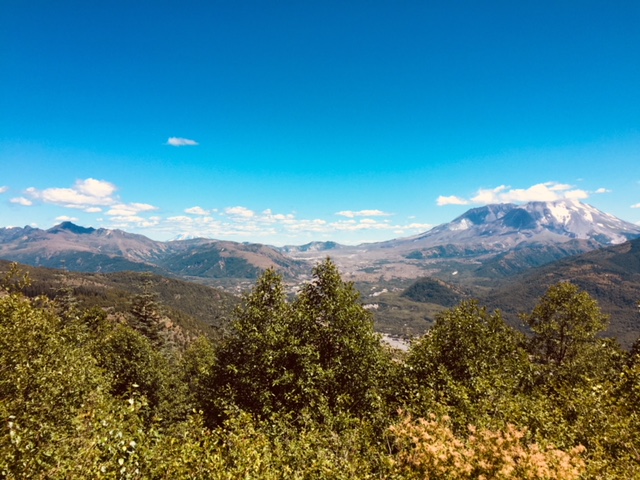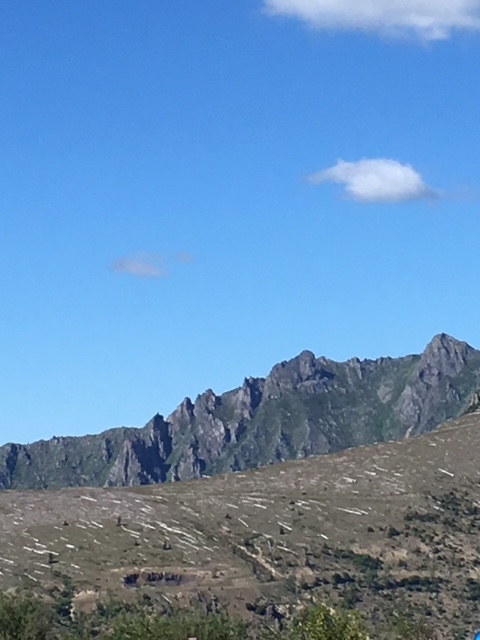Mount St. Helens, Washington
Wednesday, July 11, 2018
Clear, 77°
“Clouds of hot ash made up of pulverized rock were belched twelve miles into the sky. Giant mud slides, composed of melted snow mixed with ash and propelled by waves of superheated gas erupting out of the crater, rumbled down the slopes and crashed through valleys, leaving millions of trees knocked down in rows, as though a giant had been playing pick-up sticks.” – Time Magazine
I have had mixed emotions about revisiting the mountain again, as Mount St. Helens has held a certain mystique and wonder for the last thirty eight years. In my youth I had competed in two hang gliding tournaments in the Pacific Northwest. One was at Grouse Mountain, in British Columbia near Vancouver and the other in Chelan, Washington.
We completed the competition on May 10, hung out for six days flying and tuning our gliders for the next competition on the east coast in two weeks. It was early in the season so getting as much air time would help all of us during the long season ahead. We drove to Mount St. Helens and camped there for two nights not far from the lake. You could feel the mountain rumbling from many small earthquakes. We were in an area close to Spirit Lake, where we met an old man named Harry Truman. He told us the rangers had been warning him for days to leave his home which he was not going to do. We were back at our campsite later that evening when the ranger came by just after midnight and told us we had to evacuate. He thought the activity was increasing and it was not safe to remain. We told him we were tired with a long drive to the east coast ahead and were given permission to leave at 4:00 am, which we did.
We packed up and left in the dark heading toward Portland and then Denver on our way to Kitty Hawk, North Carolina. Mt. St. Helens blew May 18, 1980 at 8:32 am. When we stopped to refuel just outside of Denver that afternoon we first learned that the Mountain had blown. Trees were blown down for over two hundred miles and ash had covered everything for miles around. Harry Truman was gone along with beautiful Spirit Lake. To say we all were lucky cannot be stated enough, as we were going to spend at least one more night, maybe two in this beautiful place.
Today, I am returning to camp at Seaquest, a State Park Campground that is on the road up to the observatory; we checked in and then drove the 45 miles up through the mountains to the Johnston Ridge Observatory. (David A. Johnston was a volcanologist with the U.S. Geological Survey. He was monitoring Mount St. Helens from the observation post called Coldwater II on the day of the eruption. The site of the new observatory bears his name.)
Mount St. Helens Volcanic Monument
I expected to see miles and miles of trees down like toothpicks scattered about like the Time magazine photos from so long ago. I was surprised to see that some new forest outside the Mount St. Helens National Volcanic Monument were replanted in 1983 and had been doing well. Those trees were all uniform in appearance, neatly planted in rows with even spacing. It appeared, driving along, that you were looking at a giant 3D picture looking for the image to pop out of the forest. There were no flags, eagles, fish, or other objects popping out of the image ahead, just thousands of trees making a comeback after the devastation.
As we continued the climb up, there were several overlooks which gave you the first views of the mountain’s north side.
First view of the mountain
With each overlook and finally arriving at the Observatory, you could see the full impact of the explosive event. The mountain top had been blown apart sideways, not vertically as one would expect. The sideways blast caused the upper part of the mountain’s glaciers to fall inside the lava dome and when it exploded the heat and water sent out a steam blast, rocks, debris, and ash at over 300 miles per hours.
Moonscape appearance
It leveled trees in its path for over two hundred miles, created a mud/tree filled flow that covered Spirit Lake, and sent mud and ash down the river for miles. In some places it was over 600 feet thick. Rock shot out of the top of the mountain over three miles into the air creating “rock piles” called hummocks for miles around the mountain.
Hummock Piles all over the landscape
Everything looked like a lunar landscape back then. Even today, there is still a desolate ash-covered look to things. A rush of mud, trees, debris and steam cloud rushed over the ridge of the Observatory and continued for over thirty miles. Fifty seven people died when Mount St. Helens erupted.
The National Park Service has not touched the downed trees or habitat within the Monument so you can still see thousands of fallen trees where they were when felled that morning.
Blown down trees - 38 years ago
There has been a gradual comeback of the earth in the area and scientists are continually studying the effects from the event.
Flowers making a comeback
Red flowers with Hummock piles below
The Observatory has compiled a great deal of information and exhibits about the blast and its aftermath. These are a must see if coming to this historical monument. The film presentation with footage of the blast is exceptional and ends with the movie screen going up . . . the wide wrap-around curtain is opened and the view of Mount St. Helens is right outside the window for you to see.
Panorama view of Mount St. Helens
A truly breathtaking moment by far, the mountain is still several miles away but it looks like you could reach out to it, as the sense of distance and depth are not relevant in such a huge scale.
Looking over the edge into the valley below the mountain, you can see several elk in the area eating or resting in the shadow of the mountain. You can see the rebirth of Spirit Lake to the south and the canyon-like cuts along the river leading down the mountainside toward the northwest.
It was an interesting day. It was good to see all the changes to the mountain, the areas affected by the blast, the new regrowth of some trees, flowers, and a comeback of the animals.
Chipmunk with the flowers
The drive back to the campground seemed quicker than going up the mountain and the evening brought with it the first campfire of the trip,
First campfire on the trip
Most states out west had forest fires or were so dry that all fires were banned. Travelling through five fires had certainly given me a sinus infection and cough for the last several weeks. Traveling Life’s Highways keeps providing surprises and wonderful beauty along the way.










